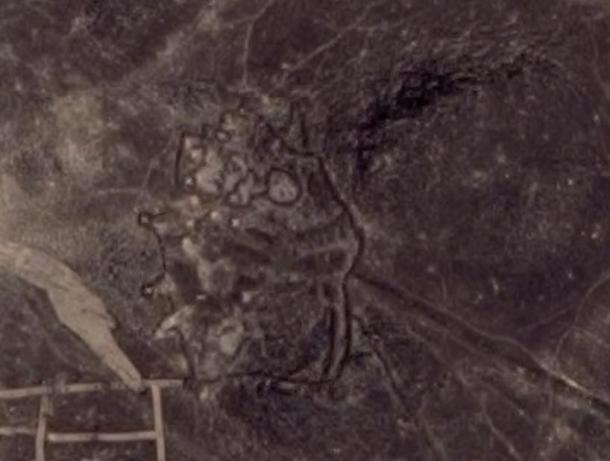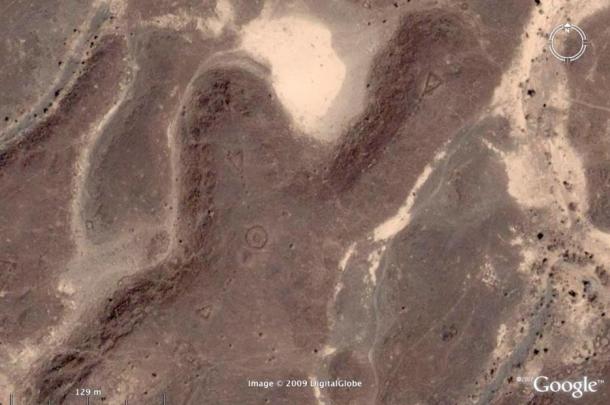These Mysterious Geoglyphs in Jordan Are 6,000 Years Older Than Peru’s Nazca Lines
Although the finished product of giant earth designs has been difficult to discern, archeologists recently announced that at least some of the great “works of old men” (as the Bedouin called them in 1927) of the Middle East are significantly older than the famous Nazca Lines of Peru.
Researchers have also shown that, in the past, one cluster of the wheels could have been linked with astronomical knowledge and that some of the geoglyphs were probably connected with the burials.
It has been concluded by archeologists that at least two of the giant Wadi Al Quattafi ‘ Wheels ‘ from Wadi Al Qattafi and the Wisad Pools, in the Black Desert of Jordan are at least 8,500 years old – making them older than the famous Nazca Lines in Peru by about 6,000 years.
BBC reports that by using optically stimulated luminescence ( OSL), the archaeologists were able to show not only the date of creation of the two wheels but also that one of them was repaired about 5,500 years ago.
The research, soon to be published in the journal Antiquity, demonstrates that at the time of the creation of these two wheels the climate of the Black Desert would have been very different, making life in the area easier.

Archaeological evidence for their claim came in the form of “Charcoal from deciduous oak and tamarisk [a shrub that] were recovered from two hearths in one building dated to ca. 6,500 BC.”
Furthermore, Discovery News has reported that the recent study suggests that at least some of the geoglyphs are related to an astronomical interest by the ancient inhabitants.
Specifically, they have found importance in one group of designs in the Azraq Oasis, as “The majority of the spokes of the wheels in that cluster are oriented for some reason to stretch in a SE-NW direction – where the sun rises during the winter solstice.” This may be no more than an educated “hunch” however, as other geoglyphs in the area do not show apparent “archaeoastronomical information.”
The two wheels and the cluster make up just a small section of the famous “Works of Old Men” that cross the Arabia region – “from Syria across Jordan and Saudi Arabia to Yemen” according to the researchers from the current study.
The geoglyphs of the Middle East were first spotted in 1927 by RAF Flight Lt. Percy Maitland, while he was flying an airmail route over Jordan. he has written.
Some of the wheel-shaped structures are clustered closer together, while others appear to be solitary. Some structures have more of a rectangular shape, while many of them are round. Some of the circular structures contain two spokes that form a bar…The wheels are sometimes found on top of the kites.

The purpose of the geoglyphs probably varied according to their location and/or design.
Gary Rollefson, co-director of the Eastern Badia Archaeological Project, says that “The presence of cairns suggests some association with burials since that is often the way of treating people once they died.” However, he was also quick to add that “there are other wheels where cairns are entirely lacking, pointing to a different possible use.”
Regarding the construction of the geoglyphs, it is evident that quality also differs from one structure to the next. Speaking of the two wheels in the Black Desert, Rollefson said that they “are simple in form and not very rigidly made, according to geometric standards.
They contrast sharply with some other wheels that appear to have been set out with almost as much attention to detail as the Nazca Lines.” The precision of the other wheels may have been due to the use of a long rope and a stake.
In contrast to the designs located further north, David Kennedy, co-director of the Aerial Photographic Archive for Archaeology in the Middle East (APAAME) has said that the forms in Saudi Arabia and Yemen “tend to be small and have only one or two bars instead of spokes.
Some of the “wheels” are actually shaped like squares, rectangles or triangles.” The APAAME has also noted kites and interconnecting walls of stones, which he has dubbed as “gates.”

APAAME is currently unable to conduct on-site or aerial imaging research of the “wheels” in Saudi Arabia and Yemen, thus they are studying aerial images from the 20th century and free satellite imaging from Google Earth and Bing for now.





